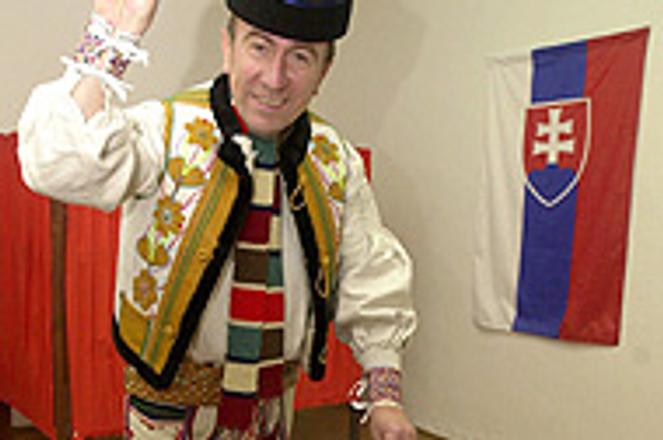Only a few exercised their patriotism.
photo: TASR
SLOVAKIA scored a new record as far as low voter turnouts go. Roughly 11 percent of eligible voters cast their ballots in the December 10 run-off elections that determined who will head the country's higher territorial units (VÚCs).
Although the first election round on November 26 drew just 19 percent of the vote and thus signalled the public's general disinterest in regional elections, observers were unpleasantly surprised to see that the run-offs, in which eight VÚC chairmen were elected, plummeted to a mere 11.1 percent.
Per region, Nitra garnered the highest turnout with 16.19 percent of registered voters. Trenčín reported the lowest, drawing only 7.12 percent (see table page 2).
The run-offs resulted in victory for current parliamentary opposition candidates. Robert Fico's Smer party saw five of its eight candidates (including independents backed by Smer) win VÚC chairman seats. The other opposition party, Movement for a Democratic Slovakia, succeeded with three candidates (see table on page 2).
The coalition parties did not manage to repeat their election success in the first round of the VÚC election, however. While in the first round, coalition parties took half of the 412 regional councillor seats, they won nothing in the run-off elections for VÚC chairmanships.
Analysts warn that the composition of some regional governments, which include predominantly pro-coalition politi-cians and opposition chairmen, will lead towards political tensions. The new VÚC representatives will convene in January of next year.
According to Peter Mach, the head of the Slovak Statistics Office, the 11.1 percent figure is the lowest voter turnout ever in the history of elections since Slovakia declared independence.
President Ivan Gašparovič was among those who expressed major disappointment.
"It's not only the fault of politicians, but also of the public, because they don't want to grasp that only they can change the state of affairs. In the vote itself, the politician is secondary. It's the voter who is most important," Gašparovič said.
Speaker of Parliament Pavol Hrušovský thinks that politicians must become more aware of the negative atmosphere in society, which puts voters off and makes them disinterested in public affairs. Hrušovský also thinks that politicians failed to efficiently explain the importance of regional governments.
Smer's Fico pinned the low turnout to bad weather, lack of information about the elections, as well as public apathy and distaste with politics.
According to Pavel Haulík, political analyst with the MVK agency, "It really makes no difference whether the turnout is 18 or 11. In both cases, it is way too low."
He thinks low turnout has been a problem for a while. "Although it is not likely that the general election next year will see such an extremely low turnout, we can expect to see a lower turnout than in previous years," Haulík told The Slovak Spectator.
There are many factors that influence low turnout, according to the analyst, including "a disillusionment with politics in general" as well as the way Slovak political parties behave.
"Another factor is the failure of the current VÚC representatives to meet the public's expectations on how the regional units should operate. They did not convince voters that VÚCs are necessary at all," said Haulík.
According to some analysts, low turnout to some extent decreases the legitimacy of the elected officials.
It also creates ways for non-standard forces to enter politics, warns Ivan Šimko, an independent MP who was a member of the general VÚC election committee.
"The decreasing interest of the people in public affairs is a threat to the basics of the democracy and a feeding ground for the arrival of autocratic ideologies and leaders," Šimko said in an official statement released after the election results were announced.
Haulík agrees. "This is a real threat for the future. Such low turnout creates space for various extremist groups, parties promoting various dangerous ideologies," Haulík said.
He noted that the run-off regional election results were actually so tight that if 22,000 more voters cast their ballots - a mere 0.5 percent of Slovakia's eligible voters - the results in six of the eight regions could have been overturned. In other words, the current losers could have won.
According to Haulík, this slim margin points to an affair that surfaced in the Prešov region, in which VÚC Chairman elect Peter Chudík was alleged to have hauled Roma to polling stations to cast their vote in his favour.
Chudík rejects the allegations.
The election results in VÚC chairman election run-offs
Region
Candidate backed by
% of votes
Bratislava VÚC
Vladimír Bajan
Ľubomír Roman
 
 
Independent
ANO, DS, SDKÚ, SMK, SZS
 
 
67.39
32.6
Trnava VÚC
Tibor Mikuš
Jozef Klokner
 
 
ĽB, HZDS, P SNS, ZSNS
DS, KDH, SDKÚ
 
54.74
45.25
Nitra VÚC
Milan Belica
Ján Greššo
 
ASV, KSS, ĽB, HZDS, P SNS, ZSNS
DS, SDKÚ
 
74.08
25.91
Trenčín VÚC
Pavol Sedláček
Miroslav Chovanec
 
ANO ,HZDS, P SNS, ZSNS
HZD, KDH, SF, SNS, SMER
 
51.83
48.16
Žilina VÚC
Juraj Blanár
Jozef Tarčák
 
ANO, HZD, SNS, SMER
HZDS, P SNS, ZSNS
 
51.37
48.62
Banská Bystrica VÚC
Milan Murgaš
Jozef Mikuš
 
HZD, KDH, SNS, SMER, SZS
DS, SDKÚ
 
50.88
49.11
Košice VÚC
Zdenko Trebuľa
Rudolf Bauer
 
HZD, SMER
KDH, OKS
 
57.52
42.47
Prešov VÚC
Peter Chudík
Dušan Hruška
 
HZD, SNS, SMER
DS, KDH, SDKÚ
 
53.03
46.96
Source: Slovak Statistics Office
Voter turnout by regions
Region
Turnout
Bratislava
10.72%
Trnava
9.41%
Nitra
16.19%
Trenčín
7.12%
Žilina
9.19%
Banská Bystrica
10.65%
Košice
10.82%
Prešov
13.20%
Source: Slovak Statistics Office


